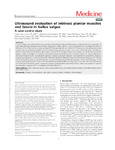Mostrar o rexistro simple do ítem
Ultrasound evaluation of intrinsic plantar muscles and fascia in hallux valgus : A case-control study
| dc.contributor.author | López-López, Daniel | |
| dc.contributor.author | Calvo-Lobo, César | |
| dc.contributor.author | Garrido-Marín, Alejandro | |
| dc.contributor.author | Rodríguez Sanz, David | |
| dc.contributor.author | Palomo-López, Patricia | |
| dc.contributor.author | Romero Morales, Carlos | |
| dc.contributor.author | Sanz Corbalán, Irene | |
| dc.date.accessioned | 2022-03-24T13:24:59Z | |
| dc.date.available | 2022-03-24T13:24:59Z | |
| dc.date.issued | 2016-11 | |
| dc.identifier.citation | Lobo, César Calvo PT, PhDa,*; Marín, Alejandro Garrido PT, MScb; Sanz, David Rodríguez PT, DP, MScc; López, Daniel López DP, PhDd; López, Patricia Palomo DP, PhDe; Morales, Carlos Romero PT, PhDc; Corbalán, Irene Sanz DP, PhDf Ultrasound evaluation of intrinsic plantar muscles and fascia in hallux valgus, Medicine: November 2016 - Volume 95 - Issue 45 - p e5243 doi: 10.1097/MD.0000000000005243 | es_ES |
| dc.identifier.uri | http://hdl.handle.net/2183/30232 | |
| dc.description.abstract | [Abstract] A cross-sectional area (CSA) and thickness reduction of the abductor hallucis (AbH) is shown in subjects with hallux valgus (HV). To date, other soft-tissue structures have not been researched in relation with HV. The aim of this study was to compare the CSA and thickness of the intrinsic plantar muscles and fascia (PF) between feet with and without HV. Therefore, a cross-sectional and case-control study was performed using B-mode with an iU22 Philips ultrasound system and a 5 to 17-MHz transducer. The CSA and thickness were measured for the AbH, flexor digitorum brevis (FDB) and flexor hallucis brevis (FHB), and also the thickness for the anterior, middle, and posterior PF portions. A convenience sample of 40 feet, 20 with HV and 20 without HV, was recruited from a clinical and research center. A multivariate regression analysis using linear regression was performed to evaluate the ultrasound imaging measurements (α = 0.05). Consequently, statistically significant differences were observed between the groups (P < 0.05) for the AbH and FHB thickness, and CSA reduction, and also the plantar fascia thickness increase in favor of the HV group. On the contrary, the FDB thickness and CSA did not show statistically significant differences (P ≥ 0.05). In conclusion, the CSA and thickness of the AbH and FHB intrinsic plantar muscles are reduced, whereas the thickness of the anterior, middle, and posterior PF portions are increased, in subjects with HV compared with those without HV. | es_ES |
| dc.language.iso | eng | es_ES |
| dc.publisher | Wolters Kluwer | es_ES |
| dc.relation.uri | 10.1097/MD.0000000000005243 | es_ES |
| dc.rights | Atribución-SinDerivadas 3.0 España | es_ES |
| dc.rights.uri | http://creativecommons.org/licenses/by-nd/3.0/es/ | * |
| dc.subject | Anatomy | es_ES |
| dc.subject | Anatomía | es_ES |
| dc.subject | Cross-sectional | es_ES |
| dc.subject | Transversal | es_ES |
| dc.subject | Hallux valgus | es_ES |
| dc.subject | Physical therapy modalities | es_ES |
| dc.subject | Modalidades de terapia física | es_ES |
| dc.subject | Ultrasonografía | es_ES |
| dc.subject | Ultrasonography | es_ES |
| dc.title | Ultrasound evaluation of intrinsic plantar muscles and fascia in hallux valgus : A case-control study | es_ES |
| dc.type | info:eu-repo/semantics/article | es_ES |
| dc.rights.access | info:eu-repo/semantics/openAccess | es_ES |
| UDC.journalTitle | Medicine | es_ES |
| UDC.volume | 95 | es_ES |
| UDC.issue | 45 | es_ES |
| UDC.startPage | e5243 | es_ES |
Ficheiros no ítem
Este ítem aparece na(s) seguinte(s) colección(s)
-
GI-UDISAP - Artigos [193]






